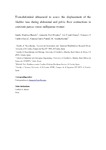Transabdominal ultrasound to assess the displacement of the bladder base during abdominal and pelvic floor contractions in continent parous versus nulliparous women

Use este enlace para citar
http://hdl.handle.net/2183/29818Colecciones
- Investigación (FFISIO) [475]
Metadatos
Mostrar el registro completo del ítemTítulo
Transabdominal ultrasound to assess the displacement of the bladder base during abdominal and pelvic floor contractions in continent parous versus nulliparous womenAutor(es)
Fecha
2021-04-19Cita bibliográfica
Martínez-Bustelo S, Ferri-Morales A, Corral-Gómez L, Castillo-García FJ, Castro-Varela V, Jácome MA. Transabdominal ultrasound to assess the displacement of the bladder base during abdominal and pelvic floor contractions in continent parous versus nulliparous women. Int Urogynecol J. 2022 Aug;33(8):2257-2266.
Resumen
[Abstract] Introduction and hypothesis: The effect of different abdominal contractions on the position of pelvic organs in parous women during postpartum exercises has not been sufficiently assessed. The aim of this study was to evaluate the displacement of the bladder base (BB) during different pelvic floor and abdominal contractions in parous women compared to nulliparous women. We hypothesised that abdominal and perineal contractions will produce a disparate effect on the position of the BB between groups.
Methods: Cross-sectional study including a convenience sample of 63 volunteers (35 nulliparous vs. 28 postpartum women). Transabdominal ultrasound was used in mode B to image the displacement of the BB. The protocol included six different pelvic floor and abdominal contractions commonly used in postpartum rehabilitation.
Results: The BB elevated significantly more in the postpartum group compared to nulliparous women when performing submaximal contraction of pelvic floor and transversus abdominis muscles simultaneously with axial elongation of the back (0.93 ± 0.55 cm in parous women vs. 0.66 ± 0.46 cm in nulliparous women). In contrast, the BB was found to descend significantly during a curl-up contraction in both groups (0.93 ± 0.55 cm in parous women vs. 0.66 ± 0.46 cm in nulliparous women).
Conclusions: The overall results of this study showed that perineal and superficial abdominal contractions produced different immediate effects compared to deep abdominal contractions on the displacement of BB in parous and nulliparous women. Further research is required to assess the long-term effects of these contractions.
Palabras clave
Abdominal muscles
Bladder
Pelvic floor muscles
Postpartum
Transabdominal ultrasound
Bladder
Pelvic floor muscles
Postpartum
Transabdominal ultrasound
Versión del editor
Derechos
This version of the article has been accepted for publication, after peer review and is subject to Springer Nature’s AM terms of use, but is not the Version of Record and does not reflect post-acceptance improvements, or any corrections. The Version of Record is available online at Springer Link.
ISSN
0937-3462





